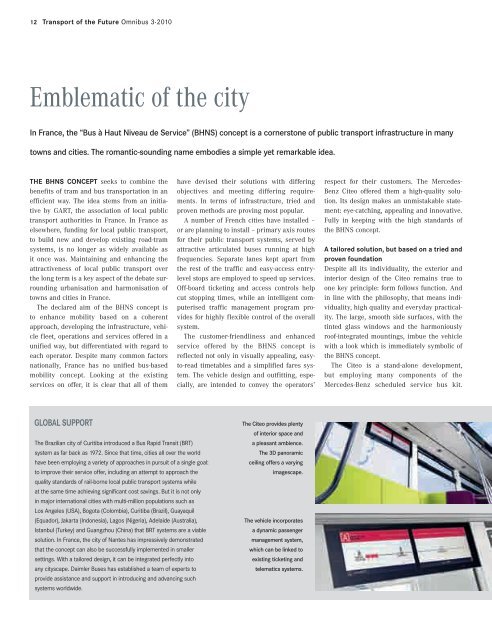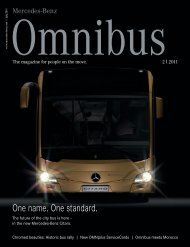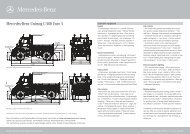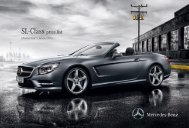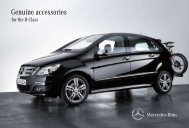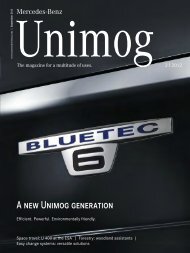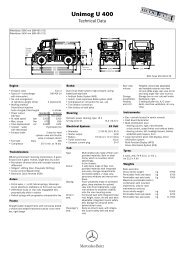magazine 2010/3 - Mercedes-Benz UK
magazine 2010/3 - Mercedes-Benz UK
magazine 2010/3 - Mercedes-Benz UK
Create successful ePaper yourself
Turn your PDF publications into a flip-book with our unique Google optimized e-Paper software.
12 Transport of the Future Omnibus 3·<strong>2010</strong><br />
Emblematic of the city<br />
In France, the “Bus à Haut Niveau de Service” (BHNS) concept is a cornerstone of public transport infrastructure in many<br />
towns and cities. The romantic-sounding name embodies a simple yet remarkable idea.<br />
THE BHNS CONCEPT seeks to combine the<br />
benefits of tram and bus transportation in an<br />
efficient way. The idea stems from an initiative<br />
by GART, the association of local public<br />
transport authorities in France. In France as<br />
elsewhere, funding for local public transport,<br />
to build new and develop existing road-tram<br />
systems, is no longer as widely available as<br />
it once was. Maintaining and enhancing the<br />
attractiveness of local public transport over<br />
the long term is a key aspect of the debate surrounding<br />
urbanisation and harmonisation of<br />
towns and cities in France.<br />
The declared aim of the BHNS concept is<br />
to enhance mobility based on a coherent<br />
approach, developing the infrastructure, vehicle<br />
fleet, operations and services offered in a<br />
unified way, but differentiated with regard to<br />
each operator. Despite many common factors<br />
nationally, France has no unified bus-based<br />
mobility concept. Looking at the existing<br />
services on offer, it is clear that all of them<br />
GLOBAL SUPPORT<br />
The Brazilian city of Curitiba introduced a Bus Rapid Transit (BRT)<br />
system as far back as 1972. Since that time, cities all over the world<br />
have been employing a variety of approaches in pursuit of a single goal:<br />
to improve their service offer, including an attempt to approach the<br />
quality standards of rail-borne local public transport systems while<br />
at the same time achieving significant cost savings. But it is not only<br />
in major international cities with multi-million populations such as<br />
Los Angeles (USA), Bogota (Colombia), Curitiba (Brazil), Guayaquil<br />
(Equador), Jakarta (Indonesia), Lagos (Nigeria), Adelaide (Australia),<br />
Istanbul (Turkey) and Guangzhou (China) that BRT systems are a viable<br />
solution. In France, the city of Nantes has impressively demonstrated<br />
that the concept can also be successfully implemented in smaller<br />
settings. With a tailored design, it can be integrated perfectly into<br />
any cityscape. Daimler Buses has established a team of experts to<br />
provide assistance and support in introducing and advancing such<br />
systems worldwide.<br />
have devised their solutions with differing<br />
objectives and meeting differing requirements.<br />
In terms of infrastructure, tried and<br />
proven methods are proving most popular.<br />
A number of French cities have installed –<br />
or are planning to install – primary axis routes<br />
for their public transport systems, served by<br />
attractive articulated buses running at high<br />
frequencies. Separate lanes kept apart from<br />
the rest of the traffic and easy-access entrylevel<br />
stops are employed to speed up services.<br />
Off-board ticketing and access controls help<br />
cut stopping times, while an intelligent computerised<br />
traffic management program provides<br />
for highly flexible control of the overall<br />
system.<br />
The customer-friendliness and enhanced<br />
service offered by the BHNS concept is<br />
reflected not only in visually appealing, easyto-read<br />
timetables and a simplified fares system.<br />
The vehicle design and outfitting, especially,<br />
are intended to convey the operators’<br />
The Citeo provides plenty<br />
of interior space and<br />
a pleasant ambience.<br />
The 3D panoramic<br />
ceiling offers a varying<br />
imagescape.<br />
The vehicle incorporates<br />
a dynamic passenger<br />
management system,<br />
which can be linked to<br />
existing ticketing and<br />
telematics systems.<br />
respect for their customers. The <strong>Mercedes</strong>-<br />
<strong>Benz</strong> Citeo offered them a high-quality solution.<br />
Its design makes an unmistakable statement:<br />
eye-catching, appealing and innovative.<br />
Fully in keeping with the high standards of<br />
the BHNS concept.<br />
A tailored solution, but based on a tried and<br />
proven foundation<br />
Despite all its individuality, the exterior and<br />
interior design of the Citeo remains true to<br />
one key principle: form follows function. And<br />
in line with the philosophy, that means individuality,<br />
high quality and everyday practicality.<br />
The large, smooth side surfaces, with the<br />
tinted glass windows and the harmoniously<br />
roof-integrated mountings, imbue the vehicle<br />
with a look which is immediately symbolic of<br />
the BHNS concept.<br />
The Citeo is a stand-alone development,<br />
but employing many components of the<br />
<strong>Mercedes</strong>-<strong>Benz</strong> scheduled service bus kit.


